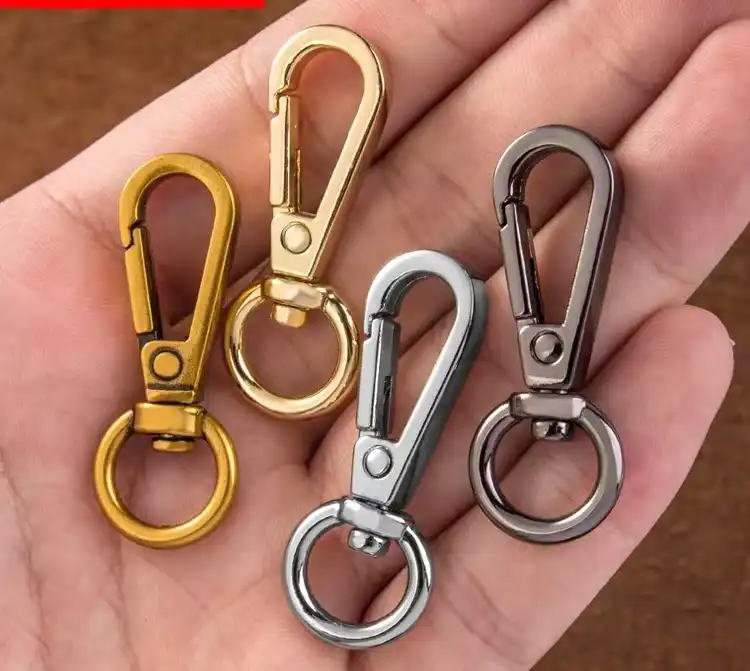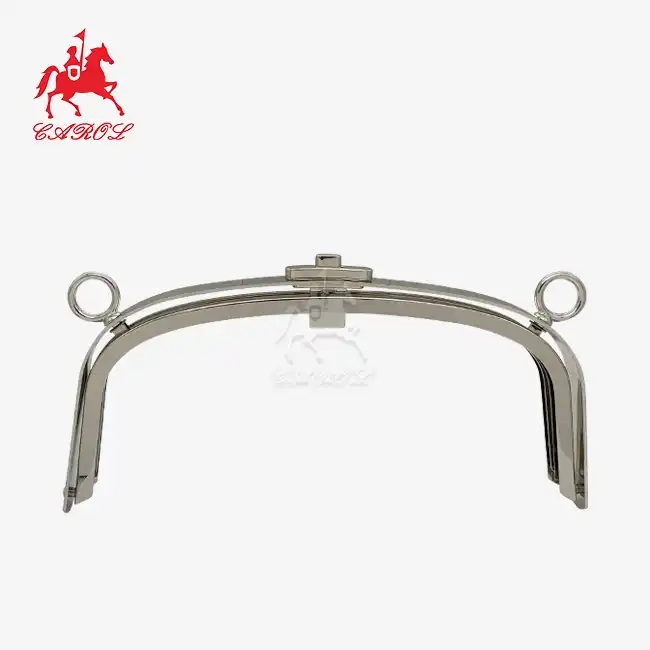Side-Release Buckles
With their dual-tab release systems that allow for intuitive operation and secure closing during regular activities, side-release mechanisms have become the most common design for dog collar buckles in modern production. While being strong enough for regular usage, these buckles are designed to release under tremendous pressure, providing a safety mechanism that can prevent choking occurrences. The one-handed action made possible by the ergonomic design is especially helpful in training or in an emergency when removing the collar quickly is essential.
Material selection in side-release buckles significantly impacts both durability and safety performance. Plastic variants, while lightweight and cost-effective, may exhibit brittleness under extreme temperature conditions or prolonged UV exposure. Conversely, metal alternatives constructed from zinc alloy demonstrate exceptional longevity and mechanical strength. Zinc alloy side release buckles offer strength and reliability, with aluminum versions capable of withstanding loads up to 900 kg, making them suitable for large breed applications or working dog scenarios.
The contoured design philosophy behind modern side-release buckles addresses anatomical considerations specific to canine neck structure. Contoured buckles have an angled or curved side profile designed to fit rounded shapes better, making dog collars much more comfortable because they conform around the neck better than flat buckles would. This design innovation reduces pressure points and hot spots that could develop during extended wear, particularly important for dogs with sensitive skin or those wearing collars continuously.
Professional applications often require enhanced reliability specifications, where standard plastic buckles prove inadequate for demanding environments. Military and working dog programs frequently specify metal side-release buckles with corrosion-resistant finishes, ensuring consistent performance despite exposure to moisture, chemicals, or extreme temperatures. The quick-release functionality remains critical in these applications, where handler safety may depend on rapid equipment disengagement.

Belt-Style Buckles
Traditional belt-style buckles employ a tongue-and-hole mechanism that provides maximum security through mechanical engagement rather than spring-loaded systems. Once fastened, buckle closures are highly secure and unlikely to come undone accidentally, offering multiple adjustment points for a precise fit and known for their durability. These designs prove particularly effective for strong-willed dogs prone to escape attempts, as the mechanical advantage required for release exceeds typical canine capabilities.
The engineering principles underlying belt-style buckles and dog buckle hardware rely on friction and mechanical interference to maintain closure, creating a system that becomes more secure under load rather than less so. Unlike quick-release mechanisms that may fail under extreme stress, traditional buckles distribute forces across the entire collar width through the tongue engagement. This characteristic makes them preferred choices for large breeds or working applications where collar integrity cannot be compromised.
Durability advantages of belt-style buckles become apparent through their simplified mechanical design, which eliminates potential failure points inherent in spring-loaded systems. The solid construction typically employs fewer moving parts, reducing wear mechanisms and extending service life. Zinc alloy construction in premium belt-style buckles provides exceptional resistance to deformation, ensuring consistent hole alignment and tongue engagement throughout the product lifecycle.
However, safety considerations require careful evaluation when selecting belt-style buckles for particular applications. The very security that makes these buckles effective for containment can become problematic if rapid collar removal becomes necessary. Emergency situations, such as collar entanglement or choking incidents, may require cutting tools rather than simple release mechanisms. Pet owners must weigh these trade-offs against their specific security requirements and environmental factors.

Quick-Release (Snap) Buckles
Quick-release buckle systems prioritize rapid engagement and disengagement through spring-loaded mechanisms designed for single-handed operation under stress conditions. Training settings, emergency response scenarios, and situations that call for the collar to be removed frequently are ideal places to use these customized closures. Accurately calibrating the spring tension and selecting durable materials are essential to the engineering problem of achieving a balance between ease of release and sufficient security during everyday activities.
Mechanical reliability in quick-release systems depends heavily on material properties and manufacturing precision, where even minor variations in spring tension can compromise functionality. Professional-grade quick-release buckles often incorporate redundant safety mechanisms to prevent accidental opening while maintaining rapid release capabilities. The zinc alloy buckle and tight stitching make collars robust and reliable, allowing pets to play without worrying about breakage or loosening, while the quick-release feature ensures easy collar application and removal.
The psychology of quick-release operation considers both human and canine factors in design implementation. Handlers must be able to operate the mechanism instinctively, even under stress or in low-light conditions, while dogs should not be able to accidentally trigger release through normal behavior. This requirement drives design features such as recessed release buttons or dual-action mechanisms that require deliberate human intervention.
Load distribution in quick-release buckles presents unique engineering challenges, where the closure mechanism must transfer forces efficiently while maintaining release functionality. Unlike belt-style buckles that distribute loads across the collar width, quick-release systems typically concentrate stress at specific points within the mechanism. Quality designs incorporate reinforcement features and material selection that address these stress concentrations without compromising release reliability.
Environmental durability testing for quick-release buckles encompasses a broader range of conditions than simpler mechanisms, including repeated cycling under various temperature and humidity conditions. The spring mechanisms and moving parts require protection against corrosion, debris accumulation, and mechanical wear that could compromise functionality over time. Premium dog buckle hardware undergoes extensive testing protocols to ensure consistent performance throughout the expected service life.

Application-specific variants of quick-release buckles address particular use cases, from lightweight options for small breeds to heavy-duty versions designed for working dogs. The size scaling involves more than simple dimensional changes, requiring recalibration of spring rates, material thickness, and engagement tolerances to maintain consistent performance across the size range. Professional applications may specify particular release force ranges to ensure reliability while maintaining safety margins.
Dog Buckle Hardware Supplier: Carol
Careful consideration of your dog's individual requirements, habits, and expected uses is required when choosing the right buckle type. From the safety of belt-style mechanisms to the comfort of side-release systems, each type of buckle has its own set of benefits that are well-suited to certain uses. At issue here is striking a compromise between operating preferences, durability expectations, and safety concerns in light of your unique circumstances.
As a professional maker, Carol knows all there is to know about the dog buckle hardware market. Metal purse frames, leather goods, and accessories for pets are her forte, but she has created and manufactured a myriad of things. From brainstorming to final packaging, Carol takes care of it all for a wide range of completed items. With a wide range of in-house capabilities, including electroplating facilities, they guarantee quality control throughout the whole production process.
The company's Factory Customized 40MM Zinc Alloy Die Casting dog hook represents advanced metallurgy applied to pet hardware applications, featuring precise dimensional control at 68mm x 40mm and optimized weight distribution at 26.6 grams. These components are available with either a Gunmetal or a Coffee E-Coating, showcasing a beautiful fusion of form and function. These parts are perfect for straps, bags, belting, leatherwork, keychains, and ID card hooks because of their zinc alloy design, which is resistant to environmental deterioration and has exceptional strength-to-weight ratios.
Professional procurement of dog buckle hardware requires suppliers capable of delivering consistent quality while accommodating custom specifications for specialized applications. Carol is able to manufacture to the specifications of her clients in terms of size, color, and material, with the use of quality control procedures that guarantee uniformity in both dimensions and finish. For procurement inquiries and technical specifications, contact tony@carolxiao.com to explore customized solutions that meet your specific dog buckle hardware requirements.
References
1. Orvis News. (2022). Dog Collars: Buckles vs. Clips. Retrieved from https://news.orvis.com/dogs/dog-collars-buckles-vs-clips
2. Pet Hardware. (2024). Metal Side Release Buckles. Retrieved from https://www.pethardware.com/en/metal-side-release-buckles/
3. Country Brook Design. (2024). Types of Dog Collar Closures. Retrieved from https://countrybrookdesign.com/hardware/buckles
4. Vivid Canine. (2024). Choosing the Right Dog Gear Hardware. Retrieved from https://www.vividcanine.com/blogs/vivid-canine-unleashed/choosing-the-right-dog-gear-hardware
5. Tech Gear Lab. (2025). The 5 Best Dog Collars of 2025. Retrieved from https://www.techgearlab.com/topics/home/best-dog-collar
_1753256285958.png)

_1754990596544.webp)









